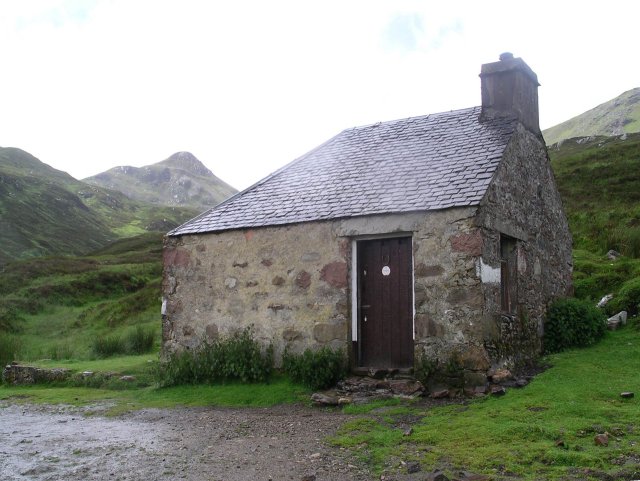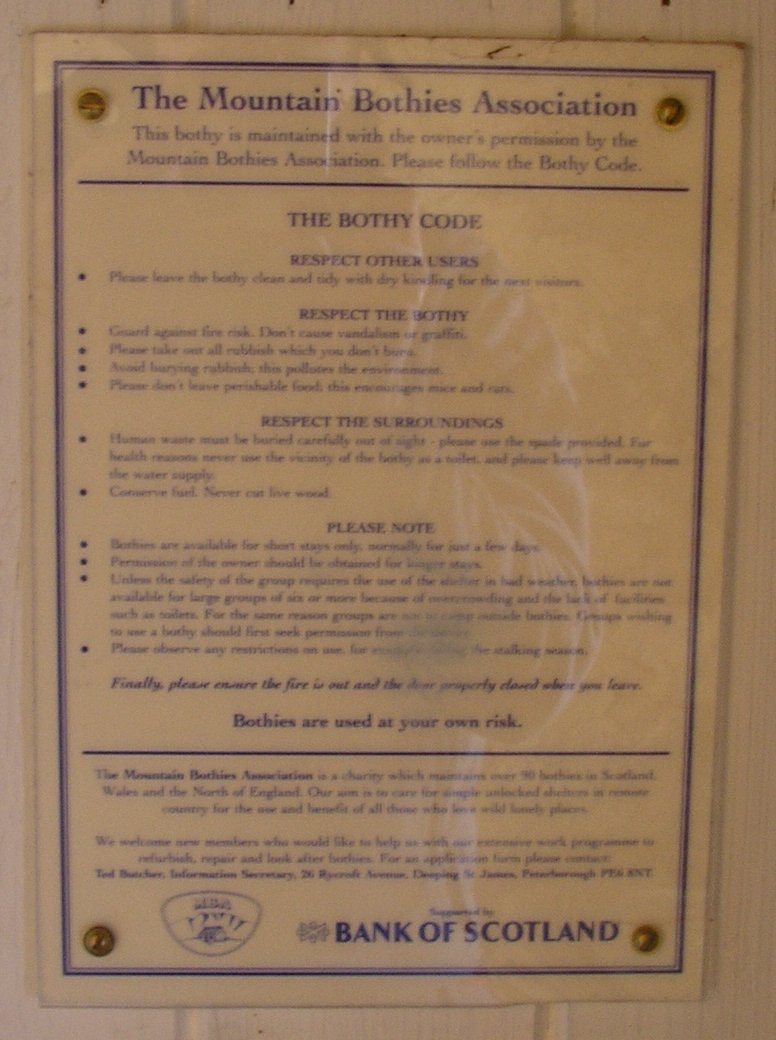Main Page
From Bothies
| (11 intermediate revisions not shown) | |||
| Line 20: | Line 20: | ||
</inputbox> | </inputbox> | ||
| - | ==[[ | + | ==[[What is a bothy?]]== |
| - | + | [[Image:Lairig_Leacach_Bothy.jpg|thumb|Lairig Leacach Bothy]] | |
| - | + | In the United Kingdom a '''bothy''' is a simple shelter, generally left unlocked and available for anyone to use without charge. Bothies are to be found in remote, mountainous areas of Scotland, Northern England and Wales: they are particularly common in the Scottish Highlands (bothy may be a corruption of the Gaelic ''botan'' meaning small hut or possibly the Welsh term ''bwthyn'' also meaning small cottage, it could also be from Norse ''būð'', cognate with English ''booth'' with a diminutive ending). | |
| - | + | Generally speaking, most bothies are formerly ruined buildings that have been restored to a basic standard, providing a windproof and watertight shelter. They vary in size from little more than a large box up to two-storey cottages. They usually have designated sleeping areas. Commonly, these are either an upstairs room or a raised platform, thus allowing one to keep clear of cold air and draughts at floor height. No bedding, mattresses or blankets are provided. Public access to bothies is either on foot or by bicycle. | |
| - | + | Most bothies have a fireplace, and are near a natural source of water. A spade is provided to bury excrement. | |
| - | + | ||
| - | + | ||
| - | + | ||
| - | + | [[Image:Bothy-code.jpg|thumb|The Bothy Code, seen at Tarf Bothy]] | |
| - | + | Although free, use of bothies is to some extent governed by an unwritten "bothy etiquette": | |
| - | + | ||
| - | + | ||
| - | + | ||
| - | + | *Fuel for the fire should be brought, or if fuel stored in the bothy is used, more should be gathered to replace what is used. Many bothies are located far from any trees, though peat may provide an alternative fuel. However, peat digging is likely to be discouraged to protect the local landscape and ecology. | |
| + | *The fire is to be used for warmth, not cooking, and a stove should be brought. | ||
| + | *Candles are usually to be found, as with fuel these should be replaced if used. | ||
| + | *All rubbish (except excrement, which should be buried) should be carried out | ||
| + | *When visiting the toilet ensure that a location away from any watercourse is used. | ||
| + | *Large groups and long stays are to be discouraged – bothies are intended for small groups on the move in the mountains. | ||
| - | Bothies are | + | Bothies are usually owned by the landowner of the estate on which they stand, though the actual owner is rarely involved in any way, other than by permitting their continued existence. Most are maintained by an organisation known as the [[Mountain Bothies Association]] (MBA), who look after around 100 bothies. |
| - | + | ||
| - | + | ||
| - | + | ||
| - | + | The location of bothies is not publicised widely – prior knowledge and word of mouth are often the only way of finding a bothy. (However, the Bothies Wiki hopes to change this.) | |
| - | |||
| style="padding: .3em .7em .4em; border: 1px solid #b9ffb9; color: #000; background-color: #f3fff3"| | | style="padding: .3em .7em .4em; border: 1px solid #b9ffb9; color: #000; background-color: #f3fff3"| | ||
==[[Bothies by Area]]== | ==[[Bothies by Area]]== | ||
| - | [[Northern Highlands]] | + | '''Please add more!''' |
| + | |||
| + | '''[[Northern Highlands]]''' | ||
*[[Achnanclach]] | *[[Achnanclach]] | ||
*[[Alladale]] | *[[Alladale]] | ||
| Line 68: | Line 65: | ||
*[[Strathcailleach]] | *[[Strathcailleach]] | ||
*[[Suileag]] | *[[Suileag]] | ||
| - | [[North West Highlands and Islands]] | + | '''[[North West Highlands and Islands]]''' |
*[[Bearnais]] | *[[Bearnais]] | ||
*[[Camasunary]] | *[[Camasunary]] | ||
| Line 83: | Line 80: | ||
*[[Craig]] | *[[Craig]] | ||
*[[The Lookout]] | *[[The Lookout]] | ||
| - | [[West Highlands and Islands]] | + | '''[[West Highlands and Islands]]''' |
*[[A'Chuil]] | *[[A'Chuil]] | ||
*[[Dibidil]] | *[[Dibidil]] | ||
| Line 94: | Line 91: | ||
*[[Suardalan]] | *[[Suardalan]] | ||
*[[Gleann Dubh Lighe]] | *[[Gleann Dubh Lighe]] | ||
| - | [[South West Highlands and Islands]] | + | '''[[South West Highlands and Islands]]''' |
*[[An Cladach]] | *[[An Cladach]] | ||
*[[Cadderlie]] | *[[Cadderlie]] | ||
| Line 107: | Line 104: | ||
*[[Tigh Seamus a'Ghlinne]] | *[[Tigh Seamus a'Ghlinne]] | ||
*[[Glengarrisdale]] | *[[Glengarrisdale]] | ||
| - | [[Central Highlands]] | + | '''[[Central Highlands]]''' |
*[[Ben Alder]] | *[[Ben Alder]] | ||
*[[Blackburn]] | *[[Blackburn]] | ||
| Line 118: | Line 115: | ||
*[[Meanachy]] | *[[Meanachy]] | ||
*[[Staoineag]] | *[[Staoineag]] | ||
| - | [[Eastern Highlands]] | + | '''[[Eastern Highlands]]''' |
*[[Allt Scheicheachan]] | *[[Allt Scheicheachan]] | ||
*[[Corrour]] | *[[Corrour]] | ||
| Line 130: | Line 127: | ||
*[[Ryvoan]] | *[[Ryvoan]] | ||
*[[Shielin of Mark]] | *[[Shielin of Mark]] | ||
| - | [[Southern Scotland]] | + | '''[[Southern Scotland]]''' |
*[[Brattleburn]] | *[[Brattleburn]] | ||
*[[Burleywhag]] | *[[Burleywhag]] | ||
| Line 142: | Line 139: | ||
*[[Tunskeen]] | *[[Tunskeen]] | ||
*[[Gameshope]] | *[[Gameshope]] | ||
| - | [[Northern England and Borders]] | + | '''[[Northern England and Borders]]''' |
*[[Blackburnhead]] | *[[Blackburnhead]] | ||
*[[Haughtongreen]] | *[[Haughtongreen]] | ||
| Line 157: | Line 154: | ||
*[[Burns]] | *[[Burns]] | ||
*[[Leysburnfoot]] | *[[Leysburnfoot]] | ||
| - | [[Wales]] | + | '''[[Wales]]''' |
*[[Arenig Fawr]] | *[[Arenig Fawr]] | ||
*[[Dulyn]] | *[[Dulyn]] | ||
Current revision as of 20:36, 27 April 2007
|
Welcome to the Bothies Wiki. About this wiki | New pages | Categories | Wiki tutorial | Help pages | |
|
A knowledge base for everything related to the British wilderness shelters! This is a wiki for you to find or deposit knowledge about bothies. There has never been an online resource for bothies before, in fact the only way that you could really find out about bothies was by word of mouth. This wiki has been set up to be made by the people who visit them. To add a new bothie or write a new article, enter the page title in the box below. <inputbox> type=create bgcolor=#f3f3ff </inputbox> What is a bothy?In the United Kingdom a bothy is a simple shelter, generally left unlocked and available for anyone to use without charge. Bothies are to be found in remote, mountainous areas of Scotland, Northern England and Wales: they are particularly common in the Scottish Highlands (bothy may be a corruption of the Gaelic botan meaning small hut or possibly the Welsh term bwthyn also meaning small cottage, it could also be from Norse būð, cognate with English booth with a diminutive ending). Generally speaking, most bothies are formerly ruined buildings that have been restored to a basic standard, providing a windproof and watertight shelter. They vary in size from little more than a large box up to two-storey cottages. They usually have designated sleeping areas. Commonly, these are either an upstairs room or a raised platform, thus allowing one to keep clear of cold air and draughts at floor height. No bedding, mattresses or blankets are provided. Public access to bothies is either on foot or by bicycle. Most bothies have a fireplace, and are near a natural source of water. A spade is provided to bury excrement. Although free, use of bothies is to some extent governed by an unwritten "bothy etiquette":
Bothies are usually owned by the landowner of the estate on which they stand, though the actual owner is rarely involved in any way, other than by permitting their continued existence. Most are maintained by an organisation known as the Mountain Bothies Association (MBA), who look after around 100 bothies. The location of bothies is not publicised widely – prior knowledge and word of mouth are often the only way of finding a bothy. (However, the Bothies Wiki hopes to change this.)
|
Bothies by AreaPlease add more!
North West Highlands and Islands
South West Highlands and Islands
|


